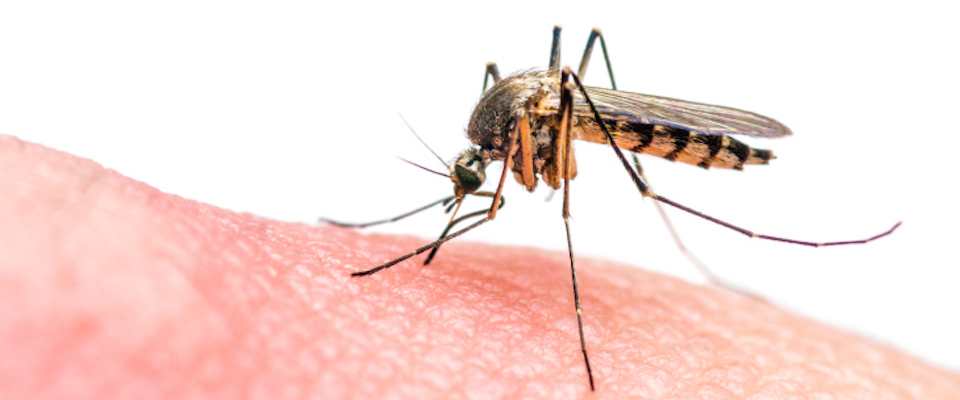West Nile infections are spiking to record levels in California, making it the country’s hot spot for the virus. And that’s something of a conundrum, given the state’s drought. Logic would dictate that the dread mosquito-borne disease would fall off during dry periods. But mosquitoes don’t need much water to propagate, and indeed, some evidence suggests that the drought may be exacerbating the problem. Swimming pools have been drained en masse in Southern California, but many retain small puddles—perfect sumps for breeding bloodsuckers.
A reduced water supply can spread West Nile in another way. Birds are a favored host for the virus. When there’s less available water, birds and mosquitoes both congregate at the few available sources. This propinquity can result in the infection of great numbers of birds, which in turn disseminate the disease broadly across the human population.
Identified in Uganda in 1937, West Nile virus is now found in most of the world’s tropical regions. It made its U.S. debut in New York City in 1999, and within five years had spread across the continental United States and much of Canada. Any of several species of mosquito can transmit the disease. Numerous animal species (virtually all birds, many mammals, and even some reptiles, notably alligators and crocodiles) are susceptible to infection; horses seem particularly vulnerable. About 80 percent of human beings are asymptomatic when infected. But roughly 20 percent will manifest symptoms of varying severity, including fever, muscle aches, rash, fatigue and vomiting. And about 1 percent will develop severe neurological complications, specifically meningitis or encephalitis.
There is no vaccine.
The virus has engendered both extreme anxiety and reactive pooh-poohing since it first made landfall in New York. It’s been kind of like killer bees: People freaked as the disease advanced inexorably across the nation, but ultimately accommodated themselves to living in a West Nile hot zone. Deaths, even severe symptoms, after all, remain relatively rare.
But to a large degree, reaction to the disease depends on—well, on one’s reaction to the disease.
“If you’re like most people and your response is subclinical, you’re likely to think it’s not a big deal,” says Fenyong Liu, a professor of infectious disease at UC Berkeley’s School of Public Health. “But if you’re one of the people who develop encephalitis or meningitis, you’re going to think it’s significant.”
Liu considers West Nile a real threat.
“You have to take all vector-associated diseases very seriously, especially when the vectors are mosquitoes,” he says. “West Nile is potentially serious, but there are other mosquito-borne diseases we have to track as well.”
That includes dengue fever, another globally-dispersed tropical malady that is also known as break-bone fever—a moniker that accurately describes the way sufferers feel. It is now well-established along the Texas-Mexico border. And that’s likely just the start.
“Taking the long view, we’ll probably see more vector-borne diseases as climate change progresses and mosquitoes discover expanded habitat,” says John Swartzberg, clinical professor emeritus at the School of Public Health. “Dengue may make inroads from the border, and there’s also concern about chikungunya, another mosquito-borne virus that causes symptoms similar to dengue. It’s originally from East Africa, and it now has moved into southern Europe, the Caribbean, and recently, Florida. With climate change, many things could be heading our way.”
As for West Nile: Despite the relatively low incidence of extreme symptoms, Swartzberg considers it a significant public health threat. Only one victim in 150 develops severe “neuroinvasive” symptoms, he says, “but if you’re in that group, you can die. There is a ten percent mortality rate for people who develop (West Nile-induced) encephalitis or meningitis. That can’t be ignored.”
Further, says Swartzberg, survivors of the neuroinvasive manifestation of the virus can suffer major sequelae—doc talk for debilitating and lingering disease after-effects.
“That can include movement and cognitive disorders, even polio-like paralysis,” Swartzberg observes. “Is it terribly common? No, but they do occur, and they’re extremely serious.”

The federal Centers for Disease Control currently lists 399 cases of West Nile in the United States. Of those, 128 are in California, with Fresno and Orange Counties reporting the largest number of victims.
“And it should be remembered that these were only the cases diagnosed and reported by physicians,” says Swartzberg, “so that’s likely the tip of the iceberg. There is no doubt that many cases are misdiagnosed or undiagnosed, and of course, many more cases are asymptomatic and not reported.”
As noted, the threat isn’t just to humans. Jan Washburn—who earned a Berkeley Ph.D. in entomology and is now a lecturer in the Department of Environmental Studies at UC Santa Cruz and representing Berkeley on the Alameda County Mosquito Abatement District board—observes that West Nile has been devastating to North America’s avian population.
“In some places, 60 percent of the bluebirds were killed,” says Washburn, an avid birder. “Prairie chickens were hit hard in the plains regions, and they were already in trouble because of habitat loss. Out here in California, we lost about half of our yellow-billed magpies, which were fairly rare even before they were affected by West Nile. And zoos lost huge numbers of birds when the virus moved from east to west.”
The appearance of new mosquito species may be compounding California’s problem. The most common carrier for West Nile in California is Culex tarsalis, a fairly voracious bloodsucker that is widely dispersed.
“But in recent years, we’ve also seen the Asian tiger mosquito and the yellow fever mosquito, both of which can transmit West Nile,” says Washburn. “We think the yellow fever mosquito may have come here in ship bilge. And we’re particularly concerned about the Asian tiger mosquito. Unlike most mosquitoes, it feeds in the daytime, and it’s really vicious.”
But that doesn’t mean West Nile is running rampant in the Bay Area—yet. A Cal student who developed severe symptoms is from Modesto, and likely contracted the disease there. Hot spots in the Bay Area include Santa Clara County, where hundreds of dead, virus-riddled birds have been found.
Washburn observes that state abatement districts have a very good system for tracking West Nile. First, piles of dead birds are a good indication you may have a problem. Second, the districts establish groups of “sentinel” chickens throughout an area, then test them regularly for West Nile antibodies. If such antibodies are detected, district staffers set mosquito traps near the affected chicken station. Any positive tests on the mosquitoes allow staffers to hone in on likely water sources, which are then intensively treated.
“In Livermore, for example, we identified two parks that had several mosquito pools where West Nile was present,” says Washburn. “In one trap, about 20 percent of the mosquitoes were infected. So we moved in with a knock-down strategy.”
That involves the targeted use of pyrethroid insecticides. The days of fogging vast areas with hard-core biocides such as DDT are long gone, emphasizes Washburn; poisons are a last resort, and used only sparingly.
“We normally control mosquitoes with biological agents such as mosquito fish and Bacillus thuringiensis, a bacterium that kills insect larvae,” Washburn says. “But when you have an acute situation with a vector-borne disease, you have to act aggressively.”
Indeed, that rationale—and the ability to implement it—may help explain why the United States is in a better position than the developing world when it comes to West Nile or any other mosquito-associated disease.
“The whole point is to educate people on the problem, and then monitor, track and treat (both patients and sources of vector activity) in an ongoing manner,” says Washburn. “That’s the basis of any sound public health program.”




















